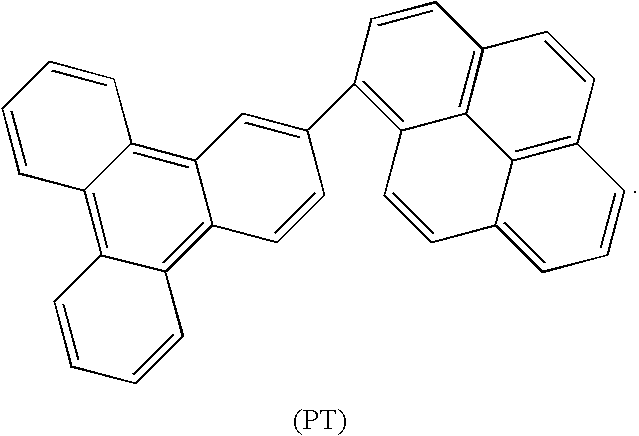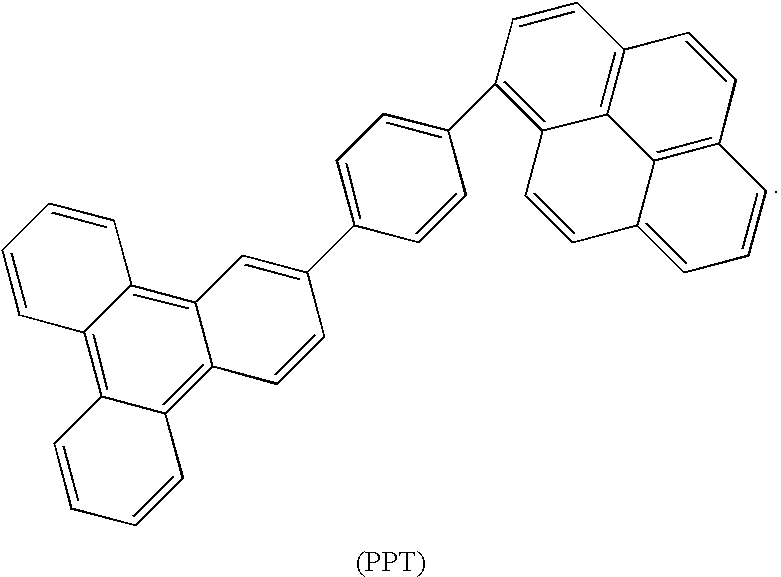Synthesis of triphenylene and pyrene based aromatics and their application in oleds
a technology of pyrene and aromatics, applied in the field of compound, can solve the problems of low efficiency of organic materials, difficult to grow large crystallization areas, and high driving voltage of devices, and achieve excellent power efficiency, high external quantum and current efficiency, and high brightness
- Summary
- Abstract
- Description
- Claims
- Application Information
AI Technical Summary
Benefits of technology
Problems solved by technology
Method used
Image
Examples
example 1
SYNTHESIS OF COMPOUND (□) (1,4-DIHYDRO-1,4-EPOXYTRIPHENYLENE)
[0039]25.7 g (100 mmol) of 9-bromophenathalene and 11.7 g (300 mmol) of sodium amide were placed in a 500 ml reaction bottle. Vacuum was developed in the reaction bottle then nitrogen was introduced into the reaction bottle, and this cycle was repeated a few times. 49.6 g (508 mmol) of furan and 200 ml of anhydrous tetrahydroxyfuran (THF) was introduced into the reaction bottle. The mixture slowly heated to 65° C. for 6 hours. Upon completion of the reaction, the reaction mixture was filtered in order to remove the salt. The filtrate was concentrated on a rotary evaporator, and the resulting solid product was purified by separation with a silica gel column. The eluent used a mixed solvent of ethylacetate: hexane=1:5. After separation, a pale yellow solid product in 80% yield was obtained.
example 2
SYNTHESIS OF PYREN-1-YL-1-BORONIC ACID
[0040]2.0 g (7.12 mmol) of 1-bromopyrene was dissolved in the anhydrous THF (100 ml) and anhydrous ether (100 ml). n-Butyllithium (4.9 ml, 7.83 mmol) was slowly dripped into the solution at −78° C. in nitrogen. The color of the solution changed from a slightly transparent yellow to light and opaque yellow solution. The solution was kept at −78° C. for ten minutes, −10° C. for ten minutes, and then −78° C. for thirty minutes. Tri-methyl borate (4.93 ml, 21.36 mmol) was slowly dipped into the solution and stirred at −78° C. for thirty minutes. The color of the solution became transparent yellow-orange. Then after keeping the solution at 0° C. for three hours, the color became transparent yellow. Finally, the solution underwent reaction at room temperature for 1.5 days. Next, 100 ml of hydrochloride aqueous solution (10%) was added into the reaction bottle and the mixture was stirred vigorously for one hour. The organic layer was extracted by ethyl...
example 3
SYNTHESIS OF ASYMMETRIC COMPOUND
[0041]1.1 eq. of 1,4-dihydro-1,4-epoxytriphenylene and 1 eq. of para-(bromo-iodo)aryl compound were dissolved in toluene under the catalysts of PdCl2(PPh3) and reduction agent of 5 eq. of triethylamine (TEA) and 5 eq. of zinc powder. The mixed solution was kept at 110° C. and stirred for one day. Thereafter, the reaction mixture was filtered in order to remove the salt. The filtrate was concentrated on a rotary evaporator, and the resulting solid product was purified over a silica gel column. Using a mixed solvent of ethylacetate: hexane (1:5) as an eluent, a white solid bromide in 78%˜91% yield was provided.
[0042]2. 1.1 eq. of 1-pyrenyl boronic acid and 1 eq. of bromo(triphenylen-2-yl) aryl were dissolved in toluene under the catalysts of Pd(PPh3)4 (5 mol %) and alkali agent of potassium carbonate (2 M). The volume ratio of toluene and potassium carbonate was 3:1. Suzuki Coupling reaction with C—C bond adding reaction was performed on the mixed solut...
PUM
| Property | Measurement | Unit |
|---|---|---|
| Time | aaaaa | aaaaa |
| Luminescence | aaaaa | aaaaa |
Abstract
Description
Claims
Application Information
 Login to View More
Login to View More - R&D
- Intellectual Property
- Life Sciences
- Materials
- Tech Scout
- Unparalleled Data Quality
- Higher Quality Content
- 60% Fewer Hallucinations
Browse by: Latest US Patents, China's latest patents, Technical Efficacy Thesaurus, Application Domain, Technology Topic, Popular Technical Reports.
© 2025 PatSnap. All rights reserved.Legal|Privacy policy|Modern Slavery Act Transparency Statement|Sitemap|About US| Contact US: help@patsnap.com



